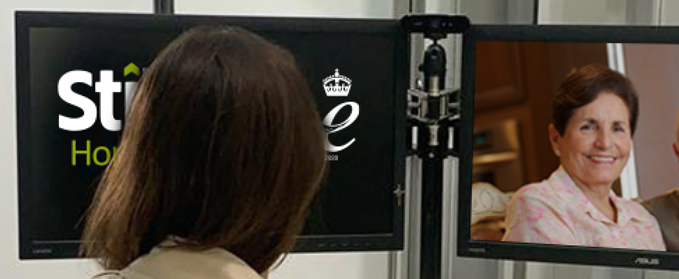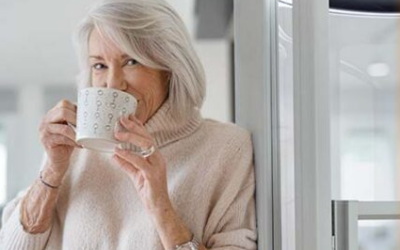The Road to Recovery:
The Impact of COVID-19 on Older Adults Mental Health and Wellbeing
The coronavirus pandemic has had a profound impact on everyone, forcing people to isolate, shield and minimise contact with friends and family. As current restrictions gradually lift, we consider not only the physical impact, but the effect coronavirus has had on mental health and wellbeing. In this Spotlight article, we look at the types of rehabilitation and the support required by clients to improve occupational performance.
 Impact on Wellbeing
The World Health Organization (WHO) has warned that the impact of COVID-19 on mental and psychosocial wellbeing will be significant and enduring. The pandemic primarily affects physical health yet has made a significant impact on mental health and wellbeing. The most noticeable impact being on older adults and those classed as high risk who were more likely to contract the virus and consequently required to shield. Social distancing and isolation can result in loneliness, loss of confidence and increase the risk of anxiety and depression, all of which are heightened if someone lives alone.
Sian Wareing Jones from the Alzheimer’s Association commented on the added pressures placed on older adults. “With age being identified as a risk factor, there’s been a great deal of fear and anxiety among older people and this has been reinforced by the language used in directives from the government, the restrictions of ‘shielding’ and messages to all of us about protecting the vulnerableâ€.
Cognitive Decline
There is evidence to suggest older adults experience a cognitive decline due to the lack of stimulating activities during the pandemic. It has also affected people with neurological disorders. According to a study carried out by Age UK, over the course of lockdown older people living with dementia have been significantly impacted by the sudden changes to routine, access to services, and reduced ability to maintain regular contact with family and friends. Carers, families, and friends of those living with dementia have seen rapid deterioration in their loved ones cognitive function, which has affected memory, sleep, mood, and behaviour.
People with pre-existing health conditions (particularly those advised to shield) have been some of the hardest hit by the pandemic; those who are classed as clinically extremely vulnerable (CEV) were advised not to leave the house at all. Not only have older people with long-term health conditions experienced reduced access to their usual healthcare, their coping methods, such as physical exercise, support groups, and day-to-day routines, have also been disrupted.
Physical Impact on Older Adults
Older adults may also experience a substantial physical impact of shielding and isolation. If there has been a decline in physical activity during periods of lockdown, it can lead to weakened muscles, deteriorating strength, balance and flexibility resulting in an overall loss of mobility. A report by Age UK states, ‘It seems that as medical experts predicted would occur, being shut away at home for long periods during this health emergency is leaving significant numbers of older people with reduced mobility and experiencing ‘deconditioning’ – a loss of physical capacity due to muscle weakness, as well as joint pain. Ordinary activities, such as going upstairs or washing, have therefore become difficult, and previously independent older people have become reliant on walking aids to move the short distances they used to manage with ease’.
Maintaining Daily Living Activities
The study continues, ‘The coronavirus pandemic has sharply accelerated the social care needs of older people, with nearly a quarter finding it harder to carry out everyday activities. Two in five (42%) who had difficulty walking up and down the stairs before the first lockdown in March 2020 reported this activity became more difficult since then’.
Direct and Indirect Effects of COVID-19
A study carried out by the Welsh Government identified there is likely to be an increased demand in rehabilitation in all settings due to the Covid-19 pandemic across four populations:
- People who contracted COVID-19 and need rehabilitation either at home or a community hospital
- People who have not received usual interventions or whose planned care has been paused, potentially causing further deterioration in their function (for example hip replacements)
- Many people refused healthcare interventions for fear of contracting COVID-19, instead choosing to manage at home with family members. A reduction in supportive clinics and rehabilitation will result negatively on physical and mental health and wellbeing
- Individuals who have been advised to shield or socially isolate due to being vulnerable may find re-integrating back into the community difficult. Anxiety and fear levels may prevent people from coming out of isolation unless they have support to do so.
The Rehabilitation Pathway
People affected both directly and indirectly by COVID-19 are likely to benefit from different elements of rehabilitation at different times in the rehabilitation pathway. The Royal College of Occupational Therapists, outlined the current, and crucial requirement for rehabilitation as follows;
- People recovering from COVID-19 infection
- People deconditioned from shielding (self-isolation/social distancing), e.g. risk of falls due to reduced muscle strength and mobility
- People experiencing mental health problems either caused or exacerbated by social isolation
- People with a range of conditions whose rehabilitation has been interrupted due to staff redeployment and cessation of face-to-face appointments during the COVID-19 pandemic
The Road to Recovery
As current restrictions ease, Occupational Therapists have a significant and lengthy role to play in the rehabilitation of people affected by COVID-19. As a healthcare professional, you can assist clients by utilising or signposting the following resources;
Your COVID Recovery
Your Covid Recovery is an online portal from NHS England to support the recovery of patients discharged from hospital post COVID-19 and those managing their illness at home. Professor Singh from the University of Leicester said: “We know the impact of COVID on people can be far reaching and complex, ‘Your COVID Recovery’ is specifically designed to support people in their recovery post-coronavirus, this will be one of the first sites in the world rolled out nationally seeking to address potential post-COVID symptoms and support people on the road to recoveryâ€. Find out more.
Social Prescribing
As a healthcare professional, you will be familiar with the term social prescribing, also referred to as personalised care or community referral. Social prescribing is the referral of clients/patients to local, non-clinical services to improve their overall health and wellbeing, usually via a link worker. As part of a team of healthcare professionals, you can actively signpost and refer your client to local community support services that enable social participation. A link worker will connect people to community groups and statutory services for practical and emotional support.
Home Adaptations
Your client’s mobility may have been affected if they have experienced muscle weakness, joint pain, deteriorating strength or balance issues. This loss of physical capability may mean navigating around the home, particularly the stairs has become difficult. This can have a significant impact on the self-confidence and wellbeing of your client. Specific home adaptations can be prescribed to enable safe and independent living whilst maintaining personal relationships, self-confidence and self-esteem.
The Benefits of a Home Lift
A home lift can be installed to ensure safe movement between floors, avoiding the risk of a trip or fall on the stairs. Cost-effective and ergonomic, Stiltz Homelifts are genuinely compact and this enables their quick installation almost anywhere in the home. The lifts are discreet, quiet and powered by a standard 240v supply and come with the option of additional safety features such as seats and handrails. A home lift can also be used to carry heavy items between floors such as washing, enabling your client to maintain their daily living activities.
The wider benefits of a home lift include;
- A reduction in injuries on the stairs, therefore admissions to A&E
- Reduce or eliminate risk to carers who previously physically carried or lifted your client up and down the stairs
- Facilitate independent living for longer, reducing the requirement for social or residential care
Disabled Facilities Grant
Your client may be eligible for a Disabled Facilities Grant if home adaptations are required to facilitate independent living. To apply for a Disabled Facilities Grant, your client should contact their local authority. Find out more in our guide to DFG’s.
In summary, the provision of personalised and occupational-focused rehabilitation has never been so important or more urgently needed. Occupational Therapists are and will continue to play a fundamental role in essential rehabilitation during and post the global pandemic, focusing on positive outcomes for clients which support meaningful, independent living.
The Impact of COVID-19 on Older Adults Mental Health and Wellbeing
The Road to Recovery:
The Impact of COVID-19 on Older Adults Mental Health and Wellbeing
The coronavirus pandemic has had a profound impact on everyone, forcing people to isolate, shield and minimise contact with friends and family. As current restrictions gradually lift, we consider not only the physical impact, but the effect coronavirus has had on mental health and wellbeing. In this Spotlight article, we look at the types of rehabilitation and the support required by clients to improve occupational performance.
Impact on Wellbeing
The World Health Organization (WHO) has warned that the impact of COVID-19 on mental and psychosocial wellbeing will be significant and enduring. The pandemic primarily affects physical health yet has made a significant impact on mental health and wellbeing. The most noticeable impact being on older adults and those classed as high risk who were more likely to contract the virus and consequently required to shield. Social distancing and isolation can result in loneliness, loss of confidence and increase the risk of anxiety and depression, all of which are heightened if someone lives alone.
Sian Wareing Jones from the Alzheimer’s Association commented on the added pressures placed on older adults. “With age being identified as a risk factor, there’s been a great deal of fear and anxiety among older people and this has been reinforced by the language used in directives from the government, the restrictions of shielding and messages to all of us about protecting the vulnerable.
Cognitive Decline
There is evidence to suggest older adults experience a cognitive decline due to the lack of stimulating activities during the pandemic. It has also affected people with neurological disorders. According to a study carried out by Age UK, over the course of lockdown older people living with dementia have been significantly impacted by the sudden changes to routine, access to services, and reduced ability to maintain regular contact with family and friends. Carers, families, and friends of those living with dementia have seen rapid deterioration in their loved ones cognitive function, which has affected memory, sleep, mood, and behaviour.
People with pre-existing health conditions (particularly those advised to shield) have been some of the hardest hit by the pandemic; those who are classed as clinically extremely vulnerable (CEV) were advised not to leave the house at all. Not only have older people with long-term health conditions experienced reduced access to their usual healthcare, their coping methods, such as physical exercise, support groups, and day-to-day routines, have also been disrupted.
Physical Impact on Older Adults
Older adults may also experience a substantial physical impact of shielding and isolation. If there has been a decline in physical activity during periods of lockdown, it can lead to weakened muscles, deteriorating strength, balance and flexibility resulting in an overall loss of mobility. A report by Age UK states, ‘It seems that as medical experts predicted would occur, being shut away at home for long periods during this health emergency is leaving significant numbers of older people with reduced mobility and experiencing deconditioning a loss of physical capacity due to muscle weakness, as well as joint pain. Ordinary activities, such as going upstairs or washing, have therefore become difficult, and previously independent older people have become reliant on walking aids to move the short distances they used to manage with ease.
Maintaining Daily Living Activities
The study continues, ˜The coronavirus pandemic has sharply accelerated the social care needs of older people, with nearly a quarter finding it harder to carry out everyday activities. Two in five (42%) who had difficulty walking up and down the stairs before the first lockdown in March 2020 reported this activity became more difficult since then’.
Direct and Indirect Effects of COVID-19
A study carried out by the Welsh Government identified there is likely to be an increased demand in rehabilitation in all settings due to the Covid-19 pandemic across four populations:
- People who contracted COVID-19 and need rehabilitation either at home or a community hospital
- People who have not received usual interventions or whose planned care has been paused, potentially causing further deterioration in their function (for example hip replacements)
- Many people refused healthcare interventions for fear of contracting COVID-19, instead choosing to manage at home with family members. A reduction in supportive clinics and rehabilitation will result negatively on physical and mental health and wellbeing
- Individuals who have been advised to shield or socially isolate due to being vulnerable may find re-integrating back into the community difficult. Anxiety and fear levels may prevent people from coming out of isolation unless they have support to do so.
The Rehabilitation Pathway
People affected both directly and indirectly by COVID-19 are likely to benefit from different elements of rehabilitation at different times in the rehabilitation pathway. The Royal College of Occupational Therapists, outlined the current, and crucial requirement for rehabilitation as follows;
- People recovering from COVID-19 infection
- People deconditioned from shielding (self-isolation/social distancing), e.g. risk of falls due to reduced muscle strength and mobility
- People experiencing mental health problems either caused or exacerbated by social isolation
- People with a range of conditions whose rehabilitation has been interrupted due to staff redeployment and cessation of face-to-face appointments during the COVID-19 pandemic
The Road to Recovery
As current restrictions ease, Occupational Therapists have a significant and lengthy role to play in the rehabilitation of people affected by COVID-19. As a healthcare professional, you can assist clients by utilising or signposting the following resources;
Your COVID Recovery
Your Covid Recovery is an online portal from NHS England to support the recovery of patients discharged from hospital post COVID-19 and those managing their illness at home.
Professor Singh from the University of Leicester said: ‘We know the impact of COVID on people can be far reaching and complex, ‘Your COVID Recovery’ is specifically designed to support people in their recovery post-coronavirus, this will be one of the first sites in the world rolled out nationally seeking to address potential post-COVID symptoms and support people on the road to recovery’.
Social Prescribing
As a healthcare professional, you will be familiar with the term social prescribing, also referred to as personalised care or community referral. Social prescribing is the referral of clients/patients to local, non-clinical services to improve their overall health and wellbeing, usually via a link worker. As part of a team of healthcare professionals, you can actively signpost and refer your client to local community support services that enable social participation. A link worker will connect people to community groups and statutory services for practical and emotional support.
Home Adaptations
Your client’s mobility may have been affected if they have experienced muscle weakness, joint pain, deteriorating strength or balance issues. This loss of physical capability may mean navigating around the home, particularly the stairs has become difficult. This can have a significant impact on the self-confidence and wellbeing of your client. Specific home adaptations can be prescribed to enable safe and independent living whilst maintaining personal relationships, self-confidence and self-esteem.
The Benefits of a Home Lift
A home lift can be installed to ensure safe movement between floors, avoiding the risk of a trip or fall on the stairs. Cost-effective and ergonomic, Stiltz Homelifts are genuinely compact and this enables their quick installation almost anywhere in the home. The lifts are discreet, quiet and powered by a standard 240v supply and come with the option of additional safety features such as seats and handrails. A home lift can also be used to carry heavy items between floors such as washing, enabling your client to maintain their daily living activities.
The wider benefits of a home lift include;
- A reduction in injuries on the stairs, therefore admissions to A&E
- Reduce or eliminate risk to carers who previously physically carried or lifted your client up and down the stairs
- Facilitate independent living for longer, reducing the requirement for social or residential care
Disabled Facilities Grant
Your client may be eligible for a Disabled Facilities Grant if home adaptations are required to facilitate independent living. To apply for a Disabled Facilities Grant, your client should contact their local authority. Find out more in our guide to DFG’s.
In summary, the provision of personalised and occupational-focused rehabilitation has never been so important or more urgently needed. Occupational Therapists are and will continue to play a fundamental role in essential rehabilitation during and post the global pandemic, focusing on positive outcomes for clients which support meaningful, independent living.

As current restrictions gradually lift, we consider not only the physical impact, but the effect coronavirus has had on mental health and wellbeing.






